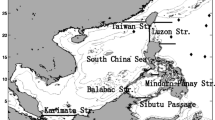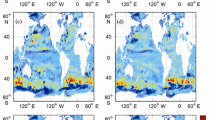Abstract
The capabilities of the ensemble Kalman filter (EKF) data assimilation (DA) method to reduce errors in simulations of concentration distributions following the accidental release of a contaminant in the ocean were evaluated. The method was tested in an idealized setting where the contaminant was released in the ocean described by a simple linear Stommel model that includes the main features of two-dimensional (2D) wind-driven circulation in the ocean on the β-plane. The wind stress curl in the right-hand side of the equation for stream function was randomly perturbed to generate an ensemble of the perturbed fields of currents. The velocity fields obtained from the ensemble of stream functions were then used for the calculation of the ensemble of concentration fields following short-duration point release. On day 1000 of the simulation, correlation coefficients of the members of the concentration ensemble and the unperturbed concentration distribution fell to 0.087. The ensemble member with the maximum deviation from the unperturbed concentration distribution was selected to be used as “truth” in data assimilation experiments. Due to the high inhomogeneity of the concentration fields, the free regularization parameter had to be defined and tuned using the L-curve approach. Different DA scenarios were considered with different topologies of measurement networks and different source locations. In all cases, data assimilation gradually brought ensemble-averaged concentration fields close to the true distribution. The root mean square errors of the analyzed concentrations on day 1000 decreased by the factors varying from 3 to 4 in different DA scenarios as compared to the simulation without DA.


source locations for the dispersion problems are shown by the following symbols: × = source location for the main dispersion scenario, and ● = source location for the additional dispersion scenario

















Similar content being viewed by others
References
Aoyama, M., Hamajima, Y., Hult, M., Uematsu, M., Oka, E., Tsumune, D., & Kumamotom, Y. (2016). 134Cs and 137Cs in the North Pacific Ocean derived from the March 2011 TEPCO Fukushima Dai-ichi Nuclear Power Plant accident, Japan. Part one: Surface pathway and vertical distributions. Journal of Oceanography, 72, 53–65. https://doi.org/10.1007/s10872-015-0335-z
Crosnier, L., Bertino, L., Drillet, Y., Huess, V., Soitillo, M., Tonani, M., Faugere, Y., Santoleri, R., Breivik, L. A., & Pouliquen, S. (2016). Evolution of the catalogue of products during Myocean2 and Myocean follow-on. Mercator Ocean Journal, (53) 20–26. Retrieved February 13, 2022, from https://www.mercator-ocean.eu/en/ocean-science/scientific-publications/mercator-ocean-journal/newsletter-54-focusing-on-the-main-outcomes-of-the-myocean2-and-follon-on-projects/
Daley, R. (1991). Atmospheric data analysis. Cambridge University Press.
Durran, D. R. (2010). Numerical methods for fluid dynamics. Springer.
Edwards, C. A., Moore, A. M., Hoteit, I., & Cornuelle, B. D. (2015). Regional ocean data assimilation. Annual Review of Marine Science, 7, 21–42. https://doi.org/10.1146/annurev-marine-010814-015821
Estournel, C., Bosc, E., Bocquet, M., Ulses, C., Marsaleix, P., Winiarek, V., Osvath, I., Nguyen, C., Duhaut, F., Lyard, T., Michaud, H., & Auclair, F. (2012). Assessment of the amount of cesium-137 released into the Pacific Ocean after the Fukushima accident and analysis of its dispersion in Japanese coastal waters. Journal of Geophysical Research: Oceans, 117, C11014. https://doi.org/10.1029/2012JC007933
Evensen, G. (1994). Sequential data assimilation with a nonlinear quasi-geostrophic model using Monte Carlo methods to forecast error statistics. Journal of Geophysical Research: Oceans, 99(C5), 10143–10162.
Evensen, G. (2003). The Ensemble Kalman Filter: Theoretical formulation and practical implementation. Ocean Dynamics, 53, 343–367. https://doi.org/10.1007/s10236-003-0036-9
Evensen, G. (2009). Data Assimilation The Ensemble Kalman Filter. Springer-Verlag.
Gautama, B. G., Longépé, N., Fablet, R., & Mercier, G. (2016). Assimilative 2-D Lagrangian Transport Model for the Estimation of Oil Leakage Parameters From SAR Images: Application to the Montara Oil Spill. IEEE Journal of Selected Topics in Applied Earth Observations and Remote Sensing, 9(11), 4962–4969. https://doi.org/10.1109/JSTARS.2016.2606110
Gent, P. (2019). Ocean Modeling II. Parameterized Physics. 2020 Community Earth System Model (CESM) Tutorial Coursework, NCAR 2020. Retrieved February 13, 2022, from https://www.cesm.ucar.edu/events/tutorials/2019/files/Lecture8-gent.pdf
Houtekamer, P. L., & Mitchell, H. L. (1998). Data assimilation using an ensemble Kalman filter technique. Monthly Weather Review, 126(3), 796–811. https://doi.org/10.1175/1520-0493(1998)126%3c0796:DAUAEK%3e2.0.CO;2
Kalman, R. E. (1960). A new approach to linear filtering and prediction problems. Journal of Basic Engineering, 82(1), 35–45. https://doi.org/10.1115/1.3662552
Kochergin, S. V., & Kochergin, V. S. (2012). Identification of the initial field of concentrations of Cs-137 in the Black Sea after the Chernobyl accident on the basis of the solution of a dual problem. Physical Oceanography, 21, 401–407. https://doi.org/10.1007/s11110-012-9132-z
Kovalets, I. (2006). RODOS System Meteorological and atmospheric dispersion module functionality enhancement by introduction of numerically efficient algorithms. Final Report of the “RODOS/ METADM—enhance”. Project No 516492 (FI6R). Retrieved October 13, 2021, from https://doi.org/10.13140/RG.2.1.3033.1043
Kovalets, I., Tsiouri, V., Andronopoulos, S., & Bartzis, J. (2009). Improvement of source and wind field input of atmospheric dispersion model by assimilation of concentration measurements: Method and applications in idealized settings. Applied Mathematical Modelling, 33(8), 3511–3521. https://doi.org/10.1016/j.apm.2008.11.013
Lawson, C. R., & Hanson, R. J. (1995). Solving least squares problems. SIAM.
Li, L., Le Dimet, F., Ma, J., & Vidard, A. (2017). A level-set-based image assimilation method: Potential applications for predicting the movement of oil spills. IEEE Transactions on Geoscience and Remote Sensing, 55(11), 6330–6343. https://doi.org/10.1109/TGRS.2017.2726013
Maderich, V., Jung, K. T., Brovchenko, I., & Kim, K. O. (2017). Migration of radioactivity in multi-fraction sediments. Environmental Fluid Mechanics, 17(6), 1207–1231. https://doi.org/10.1007/s10652-017-9545-9
Mariano, A. J., Kourafalou, V. H., Srinivasan, A. H., Kang, H., Ryan, E. H., & Roffer, M. (2011). On the modeling of the 2010 Gulf of Mexico Oil Spill. Dynamics of Atmospheres and Oceans, 52(1–2), 322–340. https://doi.org/10.1016/j.dynatmoce.2011.06.001
MARIS (Marine Information System). (2021). Radioactivity and stable isotope data in the marine environment. Retrieved October 13, 2021, from http://maris.iaea.org
Miyazawa, Y., Masumoto, Y., Varlamov, S. M., Miyama, T., Takigawa, M., Honda, M., & Saino, T. (2013). Inverse estimation of source parameters of oceanic radioactivity dispersion models associated with the Fukushima accident. Biogeosciences, 10, 2349–2363. https://doi.org/10.5194/bg-10-2349-2013
Pasmans, I., Kurapov, A. L., Barth, J. A., Kosro, P. M., & Shearman, R. K. (2020). Ensemble 4DVAR (En4DVar) data assimilation in a coastal ocean circulation model. Part II: Implementation offshore Oregon-Washington, USA. Ocean Modelling, 154, 101681. https://doi.org/10.1016/j.ocemod.2020.101681
Periáñez, R., Bezhenar, R., Brovchenko, I., Duffa, C., Iosjpe, M., Jung, K. T., Kim, K. O., Kobayashi, T., Liptak, L., Little, A., Maderich, V., McGinnity, P., Min, B. I., Nies, H., Osvath, I., Suh, K. S., & de With, G. (2019). Marine radionuclide transport modelling: Recent developments, problems and challenges. Environmental Modelling & Software, 122, 104523. https://doi.org/10.1016/j.envsoft.2019.104523
Prasad, S. J., Balakrishnan Nair, T. M., Rahaman, H., Shenoi, S. S. C., & Vijayalakshmi, T. (2018). An assessment on oil spill trajectory prediction: Case study on oil spill off Ennore Port. Journal of Earth System Science, 127, 111. https://doi.org/10.1007/s12040-018-1015-3
Rypina, I. I., Jayne, S. R., Yoshida, S., Macdonald, A. M., Douglass, E., & Buesseler, K. (2013). Short-term dispersal of Fukushima-derived radionuclides off Japan: Modeling efforts and model-data intercomparison. Biogeosciences, 10, 4973–4990. https://doi.org/10.5194/bg-10-4973-2013
Sandery, P., Brassington, G., Colberg, F., Sakov, P., Herzfeld, M., Maes, C., & Tuteja, N. (2019). An ocean reanalysis of the western Coral Sea and Great Barrier Reef. Ocean Modelling, 144, 101495. https://doi.org/10.1016/j.ocemod.2019.101495
Stommel, H. (1948). The westward intensification of wind-driven ocean currents. Transactions American Geophysical Union, 29(2), 202–206.
Suzuki, H. (2017). Numerical simulation of spilled oil drifting with data assimilation. In N. Kato (Ed.), Applications to marine disaster prevention. Tokyo: Springer.
Trieschmann, O., Hunsaenger, T., Tufte, L., & Barjenbruch, U. (2004). Data assimilation of an airborne multiple-remote-sensor system and of satellite images for the North Sea and Baltic Sea. In C. R. Bostater Jr. & R. Santoleri (Eds.), Proc SPIE 5233, Remote Sensing of the Ocean and Sea Ice 2003. Bellingham: SPIE.
van Sebille, E., Griffies, S. M., Abernathey, R., Adams, T. P., Berloff, P., Biastoch, A., Blanke, B., Chassignet, E. P., Cheng, Y., Cotter, C. J., Deleersnijder, E., Döös, K., Drake, H. F., Drijfhout, S., Gary, S. F., Heemink, A. W., Kjellsson, J., Koszalka, I. M., & Lange, M. (2018). Lagrangian ocean analysis: Fundamentals and practices. Ocean Modelling, 121, 49–75. https://doi.org/10.1016/j.ocemod.2017.11.008
Yanenko, N. N. (1971). The method of fractional steps. Springer-Verlag.
Yushchenko, S., Kovalets, I., Maderich, V., Treebushny, D., & Zheleznyak, M. (2005). Modelling of the radionuclide contamination of the Black Sea in result of Chernobyl accident using circulation model and data assimilation. Radioprotection, 40(suppl. 1), S685–S691. https://doi.org/10.1051/radiopro:2005s4-100
Zhang, S., Liu, Z., Zhang, X., Wu, X., Han, G., Zhao, Y., Yu, X., Liu, C., Liu, Y., Wu, S., Lu, F., Li, M., & Deng, X. (2020). Coupled data assimilation and parameter estimation in coupled ocean-atmosphere models: a review. Climate Dynamics, 54, 5127–5144. https://doi.org/10.1007/s00382-020-05275-6
Funding
This work was supported by the Grant of the National Research Foundation of Ukraine No. 2020.02/0048. The second author was supported by the Korea Institute of Ocean Science and Technology (grant no. PEA0012). Support of the IAEA LAMER project (Contract no. 20897) is also gratefully acknowledged.
Author information
Authors and Affiliations
Contributions
All authors contributed to the study conception and design. The method was developed by IK, calculations were carried out by IK and OS, and the analysis of computation results was performed by KOK and VM. The first draft of the manuscript was written by IK and VM. All authors commented on previous versions of the manuscript. All authors read and approved the final manuscript.
Corresponding author
Ethics declarations
Conflict of Interest
The authors have no relevant financial or nonfinancial interests to disclose.
Additional information
Publisher's Note
Springer Nature remains neutral with regard to jurisdictional claims in published maps and institutional affiliations.
Electronic supplementary material
Below is the link to the electronic supplementary material.
Appendix
Appendix
1.1 Appendix A: Solution of the equation for the stream function
This Appendix describes a method for solving Eq. (1) with the r.h.s., defined with Eqs. (3)-(4). Here the suffix, standing for the realization of the stochastic process in Sect. 2.1.1, is omitted because any of the ensemble members were considered in the same way.
When F = F0, then Eq. (1) is rewritten as:
where
The conditions \(\psi = 0\) are imposed on rectangular basin boundaries.
The solution involves a solution for homogeneous part \({\psi }_{h}\) and a particular solution \({\psi }_{p}\) for the nonhomogeneous part (Stommel, 1948)
The homogeneous part \(\psi_{h}\) is
where:
Note that due to \(Y_{k} = 0\) at \(k > 1\) in the case of constant F0, the homogeneous part is defined only by the first term of sum (13), i.e., \(\psi_{h} = X_{1} Y_{1}\). The solution for the nonhomogeneous part is
In the case of non-constant F, it is convenient to expand the r.h.s. of Eq. (11), defined by Eq. (3), into a series:
The coefficients \({F}_{k}\) could be found by calculating the respective scalar products:
where a system of functions
are orthogonal functions formed by the solution of the Sturm–Liouville problem.
The homogeneous part \(\psi_{h}\) is expressed in the same form as (13)–(17), but with
The solution of the nonhomogeneous part is obtained by summing the components:
where
Finally, the solution for first N1 terms in expansion is
In the implementation of the presented approach, N1 was set to N1 = 15 based on preliminary numerical experiments that showed that the influence of the higher-order terms in the expansion is negligibly small. For each realization of the stochastic process \(\delta F_{i} (y)\), \(1 \le i \le N\), the coefficients Fk, \(1 \le k \le 15\) entered in (19) were calculated and then used in formula (21) for calculation of the stream function in every node of the computational grid, as described in Sect. 2.1.2.
Rights and permissions
About this article
Cite this article
Kovalets, I., Kim, K.O., Shrubkovsky, O. et al. Ensemble Data Assimilation of Concentration Measurements Following the Accidental Release of a Contaminant in the Ocean: Method Testing in an Idealized Setting. Pure Appl. Geophys. 179, 1509–1530 (2022). https://doi.org/10.1007/s00024-022-02990-5
Received:
Revised:
Accepted:
Published:
Issue Date:
DOI: https://doi.org/10.1007/s00024-022-02990-5




